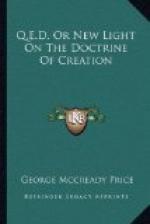But since the term has by no means been discarded, we must endeavor to determine the sense in which it continues to be used in good scientific literature.
“A species,” says Huxley, “is the smallest group to which distinct and invariable characters can be assigned.” The Standard Dictionary says that the term is used for “a classificatory group of animals or plants subordinate to a genus, and having members that differ among themselves only in minor details of proportion and color, and are capable of fertile interbreeding indefinitely.”
The latter authority also adds:
“In the kingdoms of organic nature species is founded on identity of form and structure, and specifically characterized by the power of the individuals to produce beings like themselves, who are in turn productive.”
To put the matter still more definitely before the reader, we quote the following from a well-known scientist whose writings on the subject of evolution have had a wide circulation:
“There are two bases on which species may be founded. Species may be based on form, morphological species; or they may be based on reproductive functions, physiological species. By the one method a certain amount of difference of form, structure, and habit, constitutes species; according to the other, if the two kinds breed freely with each other and the offspring is indefinitely fertile, the kinds are called varieties, but if they do not they are called species."[15]
This author adds that this physiological test, as to whether or not the kinds are cross fertile, “is regarded as a most important test of true species, as contrasted with varieties or races.”
[Footnote 15: Joseph Le Conte, “Evolution and Religious Thought,” p. 233.]
III
When we look at the matter in this light, it is very evident that there are multitudes of long recognized specific distinctions that ought to be discarded. For instance, there are some twenty odd “species” of wild pigs scattered over the Old World, which Flower and Lydekker assure us would probably “breed freely together."[16] The yak and the zebu of India, and the bison of America, would on this basis have to be surrendered, for it is well known that they will all breed freely with the common domestic cattle, as well as with one another. Perhaps all or nearly all of the dozen or more “species” of the genus Bos would thus be included together.




